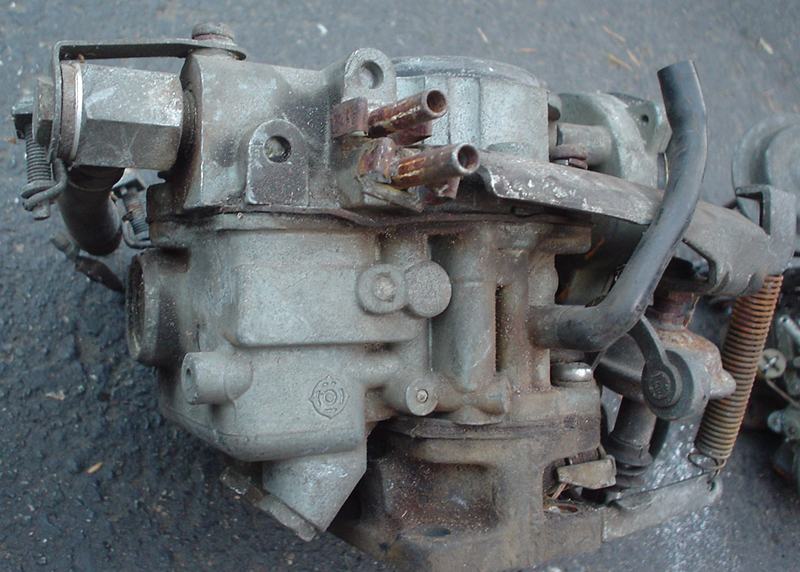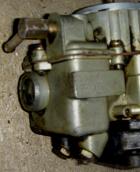B210 used Hitachi DCH306 carburetor for 1978.
Contents |
Carburetor ID
The ID is inked (not stamped) on this boss on the carburetor:
Carburetor Adjustment
The 1978 carburetors are adjusted exactly the same as the original Datsun 1200 carburetor except for the idle speed RPM number.
After obtain the idle RPM spec, see the main article: Carburetor Adjustment.
North America
5-speeds are exclusive to the FU Engine model, with unique carburetors, jetting and support for maximum fuel economy.
All B210 use A14 engine.
ALL 1978 B210 Carburetor Type: DCH306 (H = Automatic Choke) Throttle Bores: 26/30 Primary/Secondary Venturis: 23/27 Float level: 19mm Float drop h: 1.3-1.5mm Choke: center mark Choke resistance: 3.7-8.9 @ 21C (70F) Ports: * EGR port * Vacuum advance port * Choke pull-off port CARBURETOR AFFECTING SYSTEMS (all models) TCVAS which limits vacuum advance (except AT.CAN + AT.FED) Spark Delay Valve in vacuum advance line (AT.CAN + AT.FED) EFE System (heat riser) EGR ATC air cleaner with Idle Compensator Dash Pot Throttle Opener except 5-speed (FU Engine) models A.I.S. with or without air pump Catalytic Converter (CAL + FU models)
California
Manual Transmission: DCH306-11 Auto Transmission: DCH306-15
Main bleeds: 95/80 Slow jets: 45/50
DCH306-11 (M/T) Main jets: 105/145 Power jet: 40
DCH306-15 (A/T) Main jets: 104/145 Power jet: 48 * Altitude Compensator
Comments: M/T is much richer at full throttle, slightly leaner at cruising.
Canada
4-speed: same as USA 5-speed: same as USA Automatic: DCH306-12, jetted same as USA Automatic
USA
4-speed: DCH306-60 5-speed: DCH306-37 Automatic: DCH306-14
DCH306-60 (4-speed) Main jets: 104/145 Air bleeds: 110/80 Power jet: 48 Comments: Jetted Richer than CAL m/t
DCH306-37 (5-speed) Main jets: 107/145 Air bleeds: 65/60 Power jet: 48 * Fuel Shut-Off System * NO throttle opener Comments: Jetted Richer than 4-speed
DCH306-14/DCH306-12 (Auto transmission) Main jets: 104/145 Air bleeds: 95/80 Power jet: 40 Comments: Same as CAL auto except leaner full-throttle
Altitude Compensator
CAL models and all models sold in USA high altitude counties.
1978 may have 2 hose connectors near top of carburetor

For testing at low altitudes, remove the hoses and plug the ports coming out of the casting. The carburetor will run as normal.
See main article: Altitude_Compensator
Vacuum Hoses
Vacuum Advance
Vacuum advance port is always the lowest of any ports on the carburetor.
The Vacuum advance port is just above the mixture screw

Testing: Plug this port and raise RPMs to 1200. If the engine runs at fast idle better than before, there is a problem with the vacuum advance system OR the charcoal canister system (on cars so equipped). The problem could be cracked/damaged hoses, misrouted hoses, incorrectly working electrical connections, or a leaking vacuum advance unit.
You can drive the car with this plugged, but fuel economy and part-throttle power will be down slightly. It may not be quite as smooth at part-throttle driving. See main article: [Vacuum Advance]].
If your car is fitted with a Charcoal Canister, plugging this port will result in fume histeria.
EGR Signal Port
EGR port is above the the vaccum advance port. This signal gets stronger with more throttle - just the opposite of the vacuum advance signal.
Testing: Plug this port, and drive the car under varying temperatures and speeds. If the performance is markedly better, there is something wrong with the EGR system.
You can drive the car under all conditions with the EGR port plugged. Performance should be equal or better with it plugged.
Choke Pull-Off
This long black hose goes to the choke pull-off diaphragm.

Testing: Pull the lower end of this hose off the carburetor, and plug the port. If the engine now idles better, either the hose is leaking or more likely the choke pull-off diaphragm is leaking. The latter is very common with 20-year old+ carburetors.
You can drive the car with this plugged, but after a cold start it will run very rich for some seconds until the choke warms up.
Throttle Opener
The Throttle Opener bolts to the side of the carburetor but appears to be one with it and the throttle linkage. It has a single vacuum hose which goes through a switch and finally to the intake manifold.
If operating correctly, the throttle opener does not interfere with driving, although it does hold the throttle open a little during shifting.
Quick Test: Remove the hose at the intake manifold and plug it. See if the engine runs better. The car will drive OK with this plugged.
Dash Pot
If the dash pot is not working correctly, the curb idle speed can be off or erratic.
Idle jet Flat spots Just next to the plunger and in some cases accesible without moving the air horn, a jet usually with a flat head slot to turn all the way in then back to best idle. The plunger spring sits on top of the jet. Allows a low idle and causes flat spots if mal adjusted. I vaguely recall it may be part of the accelerator pump circuit.
Fuel Shut-Off System
Also See
Vacuum Leaks ATC Air Cleaner Idle Compensator

![[Datsun 1200 encyclopedia]](/wiki/upload/wiki.png)
